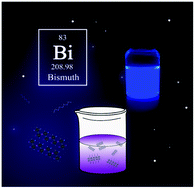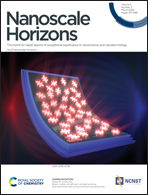Lead-free, stable, high-efficiency (52%) blue luminescent FA3Bi2Br9 perovskite quantum dots†
Abstract
Lead halide perovskites are promising candidates as next-generation emitting materials for lighting and displays due to their superior properties. However, the toxicity of lead content severely limits their practical applications. Although lead-free Sn-based and Bi-based perovskites (Cs3Bi2Br9, MA3Bi2Br9) are reported, they all suffer from low photoluminescence quantum yield (PLQY). Here, we report the synthesis of lead-free FA3Bi2Br9 perovskite quantum dots (QDs) and their optical characterization. Through a facile ligand-assisted solution process, the as-synthesized FA3Bi2Br9 QDs exhibit a bright blue emission at 437 nm with a high PLQY of 52%. As to the origins, the observed high exciton binding energy (274.6 meV), direct bandgap nature and low defect density are proposed to guarantee the exciton generation and efficient radiative recombination. Besides, the FA3Bi2Br9 QDs show a good air stability and ethanol stability. A lead-free perovskite blue light-emitting diodes (LED) was successfully fabricated by combining FA3Bi2Br9 QDs/PS composites with a UV light chip. Our results highlight the potential of lead-free perovskites for applications in light-emitting devices.

- This article is part of the themed collections: Nanoscale Horizons 10th anniversary regional spotlight collection: China, Quantum Dots: A Nanoscience Nobel Prize, Quantum Dots: Celebrating the 2023 Nobel Prize in Chemistry, Horizons Community Board Collection: Optical and Photonic Materials, 2020 Horizons Outstanding Paper Award Winners, Nanoscale Horizons 2021 Lunar New Year Collection and Nanoscale Horizons Most Popular 2020 Articles


 Please wait while we load your content...
Please wait while we load your content...